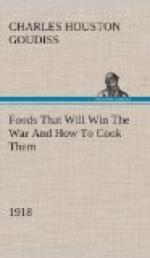The following charts, tables of nutritive values and suggested menus have been arranged to help her do this work. The American woman has her share in this great world struggle, and that is the intelligent conservation of food.
SELECTION OF MEAT
BEEF—Dull red as cut, brighter after exposure to air; lean, well mottled with fat; flesh, firm; fat, yellowish in color. Best beef from animal 3 to 5 years old, weighing 900 to 1,200 pounds. Do not buy wet, soft, or pink beef.
VEAL—Flesh pink. (If white, calf was bled before killed or animal too young.) The fat should be white.
MUTTON—Best from animal 3 years old. Flesh dull red, fat firm and white.
LAMB—(Spring Lamb 3 months to 6 months old; season, February to March.) Bones of lamb should be small; end of bone in leg of lamb should be serrated; flesh pink, and fat white.
PORK—The lean should be fine grained and pale pink. The skin should be smooth and clear. If flesh is soft, or fat yellowish, pork is not good.
SELECTION OF TOUGHER CUTS AND THEIR USES
Less expensive cuts of meat have more nourishment than the more expensive, and if properly cooked and seasoned, have as much tenderness. Tough cuts, as chuck or top sirloin, may be boned and rolled and then roasted by the same method as tender cuts, the only difference will be that the tougher cuts require longer cooking. Have the bones from rolled meats sent home to use for soups. Corned beef may be selected from flank, naval, plate or brisket. These cuts are more juicy than rump or round cuts.
1. For pot roast use chuck, crossrib, round, shoulder, rump or top sirloin.
2. For stew use shin, shoulder, top sirloin or neck.
3. For steaks use flank, round or chuck. If these cuts are pounded, or both pounded and rubbed with a mixture of 1 part vinegar and 2 parts oil before cooking, they will be very tender.
4. Soups—Buy shin or neck. The meat from these may be utilized by serving with horseradish or mustard sauce, or combined with equal amount of fresh meat for meat loaf, scalloped dish, etc.
DRY METHODS
1. Roasting or Baking—Oven roasting or baking is applied to roasts.
Place the roast in a hot oven, or if gas is used, put in the broiling oven to sear the outside quickly, and thus keep in the juices. Salt, pepper and flour. If an open roasting pan is used place a few tablespoonfuls of fat and 1 cup of water in the pan, which should be used to baste the roast frequently. If a covered pan is used basting is unnecessary.




